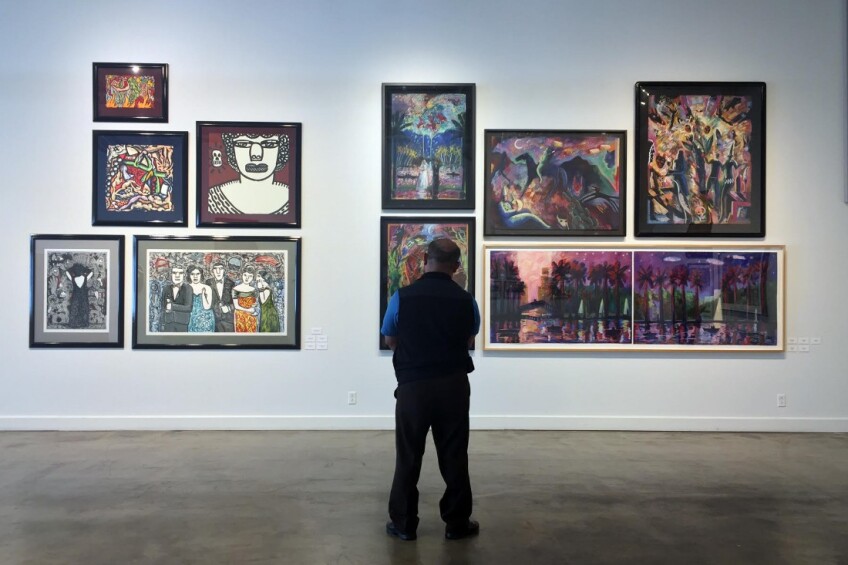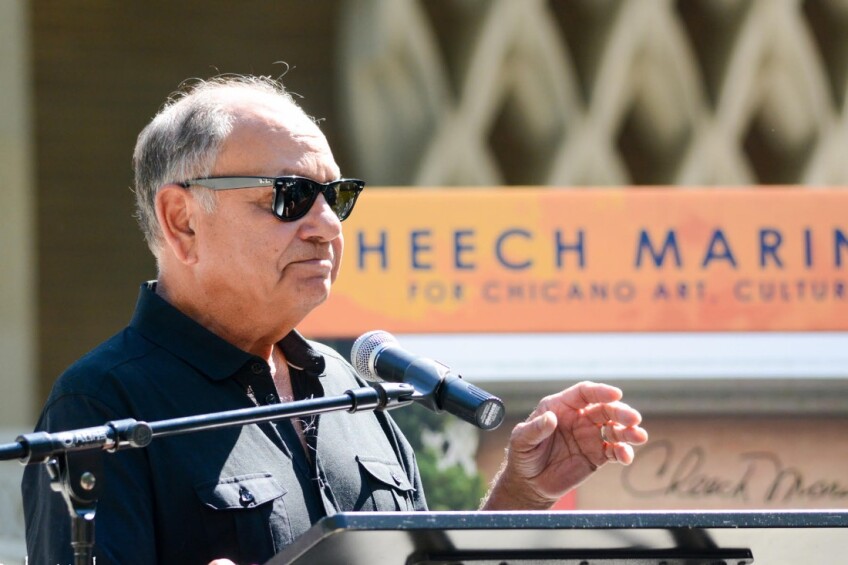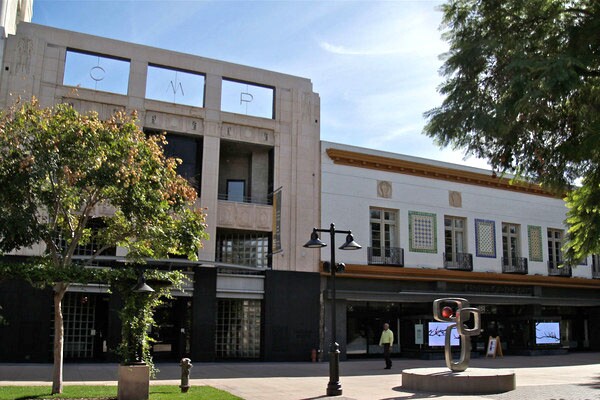The Getty, the Broad and Now “the Cheech”?


Comedian, actor and Chicano art collector Richard “Cheech” Marin announced a proposal last week to convert the 1965 Riverside Public Library into a museum to house his collection of Chicano artworks. He wore shades to protect his eyes from the sun and to hide some tears from the crowd, touched by being offered a building to mark 30 years of advocacy and purchases.
“I have not even dreamed of this dream,” Marin said at the last week’s news conference with the city of Riverside, which owns the building, and the Riverside Art Museum, which will staff the museum to be named The Cheech Marin Center for Chicano Art, Culture and Industry. Or simply “the Cheech,” as Marin suggested. It’s a moniker with instant gravitas for a project that speaks to a cultural legacy.

“It was the hardest secret I ever had to keep in my life,” said Marin that morning.
“We couldn’t tell anyone,” recalls Melissa Richardson Banks, who shepherds Marin’s collection around the U.S. as an exhibition producer.
“I kept asking about the collection ...what his plans were for it," said Carolina Miranda, cultural reporter for the Los Angeles Times, who is writing a book on Marin. "He kept demurring. This was why."
Though the news was in stealth mode, talks may have started during his current exhibition of 65 works in “Papel Chicano Dos: Works on Paper, from the collection of Cheech Marin” at the Riverside Art Museum (RAM), which broke opening night attendance records in February. The exhibit’s opening month tripled the average admission numbers.
“Cheech Marin has assembled a brilliant collection of work by Chicano artists and is so very generous in his willingness to share them,” said Todd Wingate, RAM’s Curator of Exhibitions and Collections, in a news release. He goes on to note how a unique relationship was building. During the run, Marin donated 26 archival-quality prints from his collection to RAM.
“I pledge $1,000,” someone in the audience shouted during the press conference, an early step in raising an estimated $5 million needed to convert the library into a museum (A new Riverside Public Library is scheduled to be constructed a few blocks away). A memorandum of understanding will be presented to the Riverside City Council on May 16, and when, or if, approved, the Riverside Art Museum and the city will have a year to present cost estimates for the renovation of the library building and operating expenses.
“It was a private collection because no other museum was collecting it,” said Marin, adding that a museum is not just about continuing his life’s work positioning Chicano Art as an American art movement, but to create a research site dedicated to the prints, sculptures, illustrations and paintings that make up the collection.
Marin confirmed this a few days later, still buzzing from the early reaction about the news:” Out of the blue the building was offered,” he said before recreating his reaction to the city’s proposal. “Yea,” he said with a pause that belied the rush of big ideas that came to his head immediately. “I think I can do that.”
“The area has a 50 percent Latino population, with institutions of higher learning,” he adds, and says the center will allow scholastic appreciation of the cultural aspect of the collection and the region.
There are talks to integrate programming with many of the nearby universities, which includes the University of California, Riverside; University of Redlands; California State University, San Bernardino; California Baptist University; and La Sierra University, along with Riverside City College, San Bernardino Community College, and San Bernardino Valley College.
“This is such a natural [fit]. It’s absolutely the right place for it. I want to address Inland Empire,” said Marin.
The question of Chicano Art being worthy of national attention is a burden shared by the city and inland region. Why would Riverside, sometimes falsely considered a suburb of Los Angeles, be a good site for a Chicano arts center? A better question would be, “Why not Riverside?”
Over the years, the city has made efforts to create a cultural core by repurposing its older downtown buildings. The 61,420-square-foot library building, dedicated in 1965, has New Formalism architecture, a pedigree shared with the Dorothy Chandler Pavilion. One block away is the Riverside Art Museum, housed in a former YWCA designed by Julia Morgan in 1929, who is best known for designing Hearst Castle.
In the other direction, a few blocks away, the UCR/California Museum of Photography reveals an elegant façade of a former Kress building, built in 1930. It is connected to the Jack and Marilyn Sweeney Art Gallery and the Barbara and Art Culver Center of the Arts in a converted 1895 Rouse Department Store. Together it is ARTSblock; where “Mundos Alternos: Art and Science Fiction in the Americas” will be an entry of the Getty-sponsored “Pacific Standard Time: LA/LA,” an exploration of Latino Art to be held around Southern California this fall.

Across the street from the library, a former U.S. post office built in 1912, serves as the Riverside Metropolitan Museum, where Cheech’s collection was introduced to the city in September 2005 through “The Chicano Collection / La Colección Chicana: Fine Art Prints,” also produced by Banks.
The envisioned center’s neighbor is the Mission Inn, the best-known building in a city that has cultural legacy rooted to the parent navel orange tree, which made citrus history and created a citrus belt in the late 1880s comprising inland Southern California’s cities.
With the birth of the citrus belt came a labor force to pick citrus: Mexican labor began filling gaps left by nationwide Chinese exclusion and Japanese internment. By the 1940s, the citrus groves and packing houses were operating mostly with Latino laborers. Many stayed, giving the city a Latino presence for generations, anchored by enclaves in Riverside’s Eastside and Casa Blanca. Until the Cheech comes, there will be no dedicated art space that will speak to their history and culture of the city, and inland Southern California.; only a smattering of exhibitions here and there.
"What do you think of a Chicano Art Biennale?'” Marin joked. Why wait for a building? A biennale can happen now to kick off “the Cheech”. For now the news of the proposed center by Riverside’s newest homeboy converted anyone who follows Chicano Art into art dreamers.
FOR THE RECORD: On May 16, Press-Enterprise reporter Alicia Robinson tweeted that the City of "Riverside council votes 6-0 to enter agreement w/Cheech Marin to develop Chicano art center in downtown library building. Audience applauds."
Top Image: "Soy Chicana, 2013" by CiCi Segura González was featured in “Papel Chicano Dos: Works on Paper, from the Collection of Cheech Marin.”




